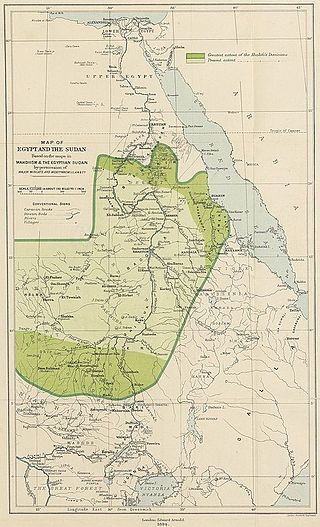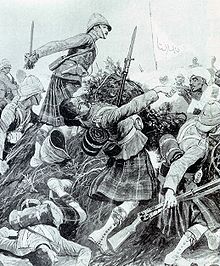
The Battle of Omdurman was fought during the Anglo-Egyptian conquest of Sudan between a British–Egyptian expeditionary force commanded by British Commander-in-Chief (sirdar) major general Horatio Herbert Kitchener and a Sudanese army of the Mahdist State, led by Abdallahi ibn Muhammad, the successor to the self-proclaimed Mahdi, Muhammad Ahmad. The battle took place on 2 September 1898, at Kerreri, 11 kilometres (6.8 mi) north of Omdurman.

Muhammad Ahmad bin Abdullah bin Fahal was a Sudanese religious and political leader. In 1881, he claimed to be the Mahdi and led a war against Egyptian rule in Sudan, which culminated in a remarkable victory over them in the Siege of Khartoum. He created a vast Islamic state extending from the Red Sea to Central Africa and founded a movement that remained influential in Sudan a century later.

The Atbarah River, also referred to as the Red Nile and / or Black Nile, is a river in northeast Africa. It rises in northwest Ethiopia, approximately 50 km north of Lake Tana and 30 km west of Gondar. It then flows about 805 km (500 mi) to the Nile in north-central Sudan, joining it at the city of Atbarah. The river's tributary, the Tekezé (Setit) River, is perhaps the true upper course of the Atbarah, as the Tekezé follows the longer course prior to the confluence of the two rivers in northeastern Sudan. The Atbarah is the last tributary of the Nile before it reaches the Mediterranean.
The Battle of Umm Diwaykarat on 25 November 1899 marked the final defeat of the Mahdist State in Sudan, when Anglo-Egyptian forces under the command of Lord Kitchener defeated what was left of the Mahdist armies under the command of the Abdallahi ibn Muhammad, known as the Khalifa, after the equally disastrous Battle of Omdurman a year earlier.

The Battle of Shaykan was fought between Egyptian forces under the command of Hicks Pasha and the forces of Muhammad Ahmad, the self-proclaimed Mahdi, in the woods of Shaykan near Kashgil near the town of El-Obeid during 3–5 November 1883.

The Mahdist State, also known as Mahdist Sudan or the Sudanese Mahdiyya, was a state based on a religious and political movement launched in 1881 by Muhammad Ahmad bin Abdullah against the Khedivate of Egypt, which had ruled Sudan since 1821. After four years of struggle, the Mahdist rebels overthrew the Ottoman-Egyptian administration and established their own "Islamic and national" government with its capital in Omdurman. Thus, from 1885 the Mahdist government maintained sovereignty and control over the Sudanese territories until its existence was terminated by the Anglo-Egyptian forces in 1898.

The siege of Khartoum took place from 13 March 1884 to 26 January 1885. Sudanese Mahdist forces captured the city of Khartoum, Sudan, from its Egyptian garrison, thereby gaining control over the whole of Turco-Egyptian Sudan.

The River War: An Historical Account of the Reconquest of the Soudan (1899), by Winston Churchill, is a history of the conquest of the Sudan between 1896 and 1899 by Anglo-Egyptian forces led by Lord Kitchener. He defeated the Sudanese Dervish forces, led by Khalifa Abdallahi ibn Muhammad, heir to the self-proclaimed Mahdi Muhammad Ahmad, who had vowed to conquer Egypt and drive out the Ottomans. The first, two-volume, edition includes accounts of Churchill's own experiences as a British Army officer during the war, and his views on its conduct.

Osman Digna was a follower of Muhammad Ahmad, the self-proclaimed Mahdi, in Sudan, who became his best known military commander during the Mahdist War. He was claimed to be a descendant from the Abbasid family. As the Mahdi's ablest general, he played an important role in the fate of General Charles George Gordon and the end of Turkish-Egyptian rule in Sudan.

The first and second battles of El Teb took place during the British Sudan Campaign where a force of Sudanese under Osman Digna won a victory over a 3,500 strong Egyptian force under the command of General Valentine Baker which was marching to relieve Tokar on the 4th. A second British force under Sir Gerald Graham arrived on the 29th, engaging and defeating Osman Digna with few casualties.

The Mahdist War was a war between the Mahdist Sudanese, led by Muhammad Ahmad bin Abdullah, who had proclaimed himself the "Mahdi" of Islam, and the forces of the Khedivate of Egypt, initially, and later the forces of Britain. After four years of revolt, the Mahdist rebels overthrew the Ottoman-Egyptian administration with the fall of Khartoum and gained control over Sudan. The Mahdist State launched several unsuccessful invasions of their neighbours, expanding the scale of the conflict to also include the Italian Empire, the Congo Free State and the Ethiopian Empire. They also faced significant internal rebellion. Anglo-Egyptian forces reconquered Sudan in 1898 and the Mahdist state collapsed following defeat at the battle of Omdurman. The last organised resistance from the Mahdists ended the next year, leading to the creation of Anglo-Egyptian Sudan (1899–1956), a de jure condominium of the British Empire, and the Kingdom of Egypt, in which Britain had de facto control over Sudan.

The Battle of Toski (Tushkah) was part of the Mahdist War. It took place on August 3, 1889, in southern Egypt between the Anglo-Egyptian forces and the Mahdist forces of the Sudan.

The Battle of Gallabat, also known as the Battle of Metemma, was fought on 9–10 March 1889 during the Mahdist War between the Mahdist Sudanese and Ethiopian forces. It is a critical event in Ethiopian history because Nəgusä Nägäst Yohannes IV was killed in this battle, and because it was the last major battle on the Ethiopian front of the Mahdist War. The fighting occurred at the site of the twin settlements of Gallabat and Metemma.

The Battle of Tamai took place on 13 March 1884 between a British force under Sir Gerald Graham and a Mahdist Sudanese army led by Osman Digna.

The Battle of Ferkeh occurred during the Mahdist War in which an army of Mahdists was surprised and routed by Egyptian forces, led by Sir Herbert Kitchener, on 7 June 1896. It was the first significant action of the reconquest of Sudan, which culminated in the September 1898 Battle of Omdurman.

The Battle of Ginnis was a minor battle of the Mahdist War that was fought on December 30, 1885, between soldiers of the Anglo-Egyptian Army and warriors of the Mahdist State. The battle was caused by the Mahdist blockade of the Ginnis-Kosha Fort, which British commanders hoped to relieve.

The Battle of Suakin, occurred on 20 December 1888 during the Mahdist War, when General Francis Grenfell defeated a Mahdist, force near Suakin, a chief port of Sudan.

The Queen's Sudan Medal was authorised in March 1899 and awarded to British and Egyptian forces which took part in the Sudan campaign between June 1896 and September 1898.

The Anglo-Egyptian conquest of Sudan in 1896–1899 was a reconquest of territory lost by the Khedives of Egypt in 1884–1885 during the Mahdist War. The British had failed to organise an orderly withdrawal of the Egyptian Army from Sudan, and the defeat at Khartoum left only Suakin and Equatoria under Egyptian control after 1885. The conquest of 1896–1899 defeated and destroyed the Mahdist State and re-established Anglo-Egyptian rule, which remained until Sudan became independent in 1956.

The Mahdi's tomb or qubba is located in Omdurman, Sudan. It was the burial place of Muhammad Ahmad, the leader of an Islamic revolt against Turco-Egyptian Sudan in the late 19th century.




















